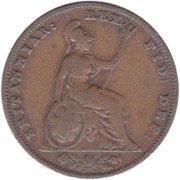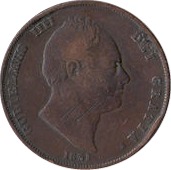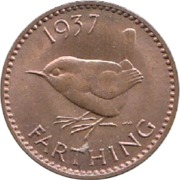 The 1837 Farthing - William IV
The 1837 Farthing - William IVWilliam IV Copper Farthing dated 1837. SCBC 3848. It was the last of the William IV farthings as the King died on 20 June 1837.
The Reverse shows Britannia, seated holding a trident and shield with Union flag. Flower emblems in exergue. Legend: "BRITANNIAR: REX FID: DEF:".
 The Obverse shows a portrait of William IV (on legend as Guilielmus IIII). Date below. Legend "GULIELMUS IIII DEI GRATIA".
The Obverse shows a portrait of William IV (on legend as Guilielmus IIII). Date below. Legend "GULIELMUS IIII DEI GRATIA".Image credit: M J Hughes Coins
Mintage: 3,010,500 (may include coins in sets)
Minted at The Royal Mint
More information (monarch, year, mint, country, category) can be found below coin listings.
Below are some coins currently being offered on eBay. As an eBay Partner, We may be compensated if you make a purchase.
List items on:
List items on:
Remember 1837 ?
The Monarch is King William IV until his death on 20 June. As none of his ten surviving children being legitimate the throne goes to his 18-year-old niece, Princess Victoria of Kent becomes Queen Victoria. The Prime Minister is William Lamb, 2nd Viscount Melbourne (Whig) and continues after the 18 August General election. Charles Dickens serialises Oliver Twist.
In the USA, the 7th President Andrew Jackson (D-Tennessee) ends his second term and on March 4 it is Martin Van Buren (D-New York). Richard Johnson becomes the only Vice President of the United States chosen by the Senate. Inventor John Deere starts his agricultural equipment business.
In the USA, the 7th President Andrew Jackson (D-Tennessee) ends his second term and on March 4 it is Martin Van Buren (D-New York). Richard Johnson becomes the only Vice President of the United States chosen by the Senate. Inventor John Deere starts his agricultural equipment business.
William IV (1830-1837)
 William IV was King of the United Kingdom of Great Britain and Ireland and King of Hanover from 26 June 1830 until his death. He was the third son of King George III, born 21 August 1765. William married Adelaide of Saxe-Meiningen and had two daughters (Charlotte and Elizabeth) but was also known to have ten illegitimate children with actress Dorithea Jordan.
William IV was King of the United Kingdom of Great Britain and Ireland and King of Hanover from 26 June 1830 until his death. He was the third son of King George III, born 21 August 1765. William married Adelaide of Saxe-Meiningen and had two daughters (Charlotte and Elizabeth) but was also known to have ten illegitimate children with actress Dorithea Jordan.Note that on coins, William IV is often written as GULIELMUS IIII. William IV is sometimes known as the 'Sailor King'. On his death the throne passed to his niece, Victoria.
Category: Farthings
The Farthing was a small British coin that was worth one-quarter of an old penny - 1/960th of a Pound. It's name derives from the Anglo-Saxon feorthing or fourthling, meaning fourth part. It was last minted in 1956. Origins of the English Farthing
Farthings were minted as early as the 13th century under the reign of Edward I, although they may have been minted earlier under Henry III. Early examples are rare. These were small silver coins but they competed with 'cut-coinage' where a penny would be literally cut into four and used as a quarter of a penny. Farthing were minted in silver, copper and tin.
British Farthings
After the Act of the Union in 1707 (which unified England and Scotland), copper farthings were minted on a more regular basis. In 1799 Matthew Boulton started producing farthings in his steam-powered Birmingham factory (famous for making the cartwheel penny and twopence). The reverse was marked '1 FARTHING' which was the first time a denomination had ever appeared on a British or English coin. It was also the first coin to have the date on the same side as the Monarch. Boulton made another batch in 1806 and the Royal Mint took over in 1821. Farthing were made under George IV and William IV and the design was generally that of a small version of a penny, with Britannia on the reverse.
Farthings were minted in most of the years of Victoria's reign. The same obverse dies were used for the copper farthing and the sovereign and probably were used for the gold coin first. Victoria was the only monarch to have two obverses: a 'Bun' head and the Old or 'Veiled' head.
1860: Bronze replaces Copper
By 1860, the government decided to switch from copper to alloys so as to improve the quality of the coinage. Pennies, halfpennies and farthings were struck in bronze, both in Birmingham and at the Royal Mint. Bronze is 95% copper, 4% tin and 1% zinc and this was used with only minor changes until the end of the farthing in 1956.
 Farthings continued to be minted almost every year and the design was the same as the penny (with Britannia on the reverse). There was a pattern design for the Edward VIII farthing in 1936 but none were actually made in production.
Farthings continued to be minted almost every year and the design was the same as the penny (with Britannia on the reverse). There was a pattern design for the Edward VIII farthing in 1936 but none were actually made in production. The Wren and Demonetisation
In 1937 the farthing at long last got it's own unique reverse: a wren, designed by artist Harold Wilson Parker. By the 1950's inflation had eroded the spending power of the farthing (which was just 1/960th of a Pound) and with it the support of the public waned too. Production was discontinued after 1956 and the coin ceased to be legal tender after 31st December 1960.
Which Mint: The Royal Mint
The Royal Mint is the designated place for the UK to mint coins. It dates back well over 1000 years and is a Government-owned company. Formed in the reign of Alfred the Great about the year 886, during the period 1279-1812 it was generally referred to as The Tower Mint as it was housed at the Tower of London. The Master of The Royal Mint has included famous figures such as Sir Isaac Newton.
Since 2010 it has operated as Royal Mint Ltd, a company owned by HM Treasury, under an exclusive contract to supply all coinage for the UK although it also produces medals and coins for other countries. It is currently located at Llantrisant, Wales.
Country of Origin: United Kingdom
The United Kingdom (UK) is the Union of England, Scotland, Wales and Northern Ireland. It is often refered to as Great Britain (GBR). It has a long, rich history. The orignal coinage was Pounds, Shillings and Pence but since decimalisation on 15 February 1971, it is £1 = 100p, that is One Pound = 100 pence. The coinage of the UK is also a long history, the Royal Mint being established as long ago as 886AD when coins were hammered. Today there is perhaps 30 billion coins in circulation, and many (numismatic) collectors coins and sets are issued frequently in gold, silver and other metals.








